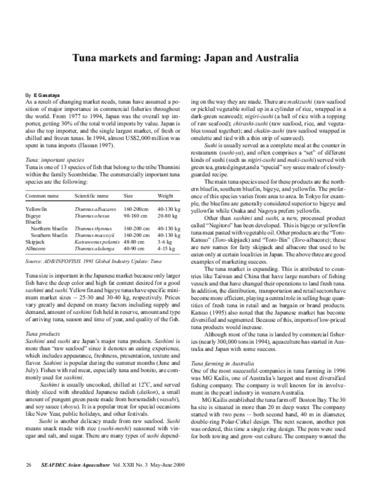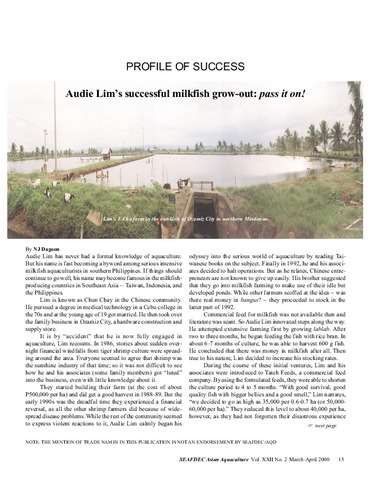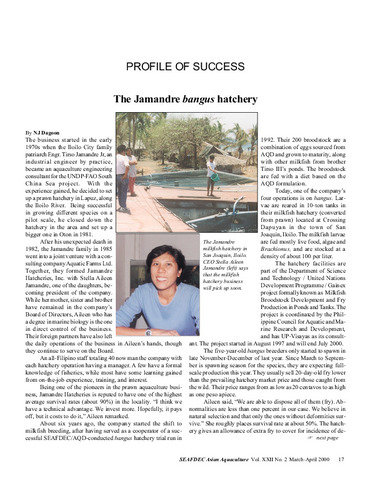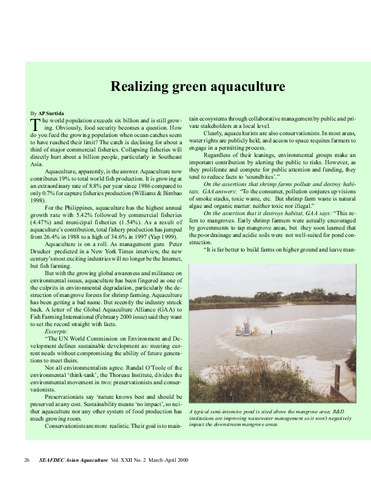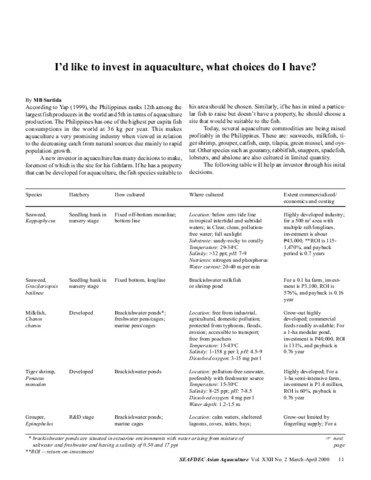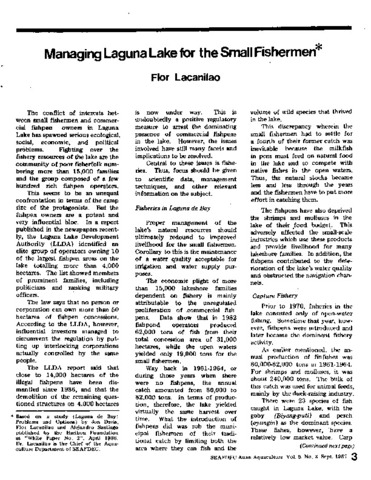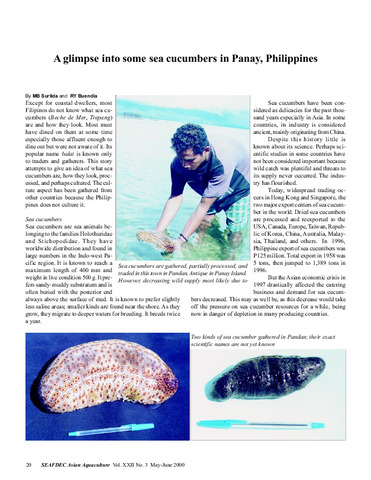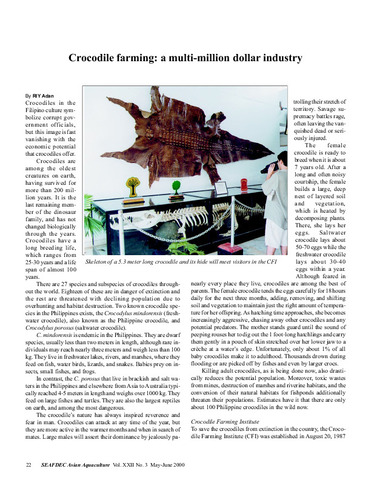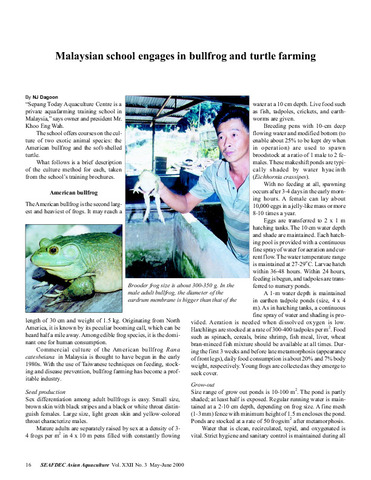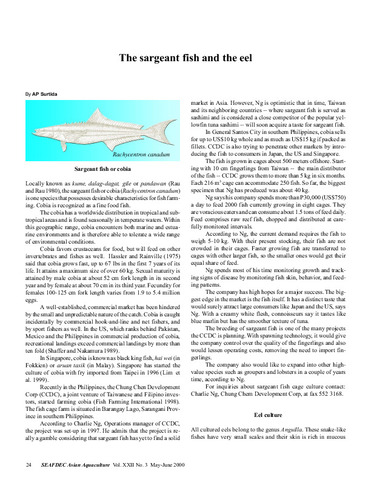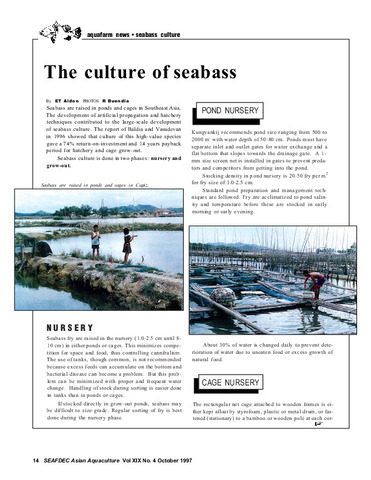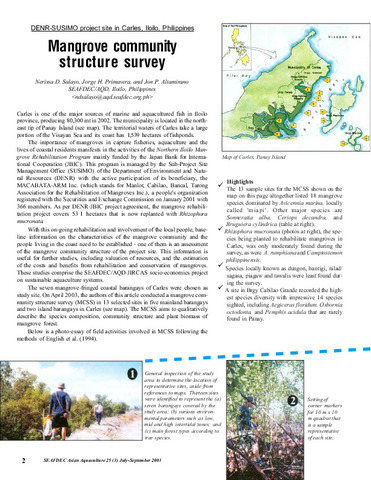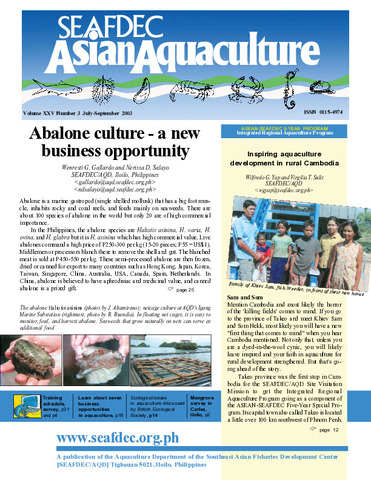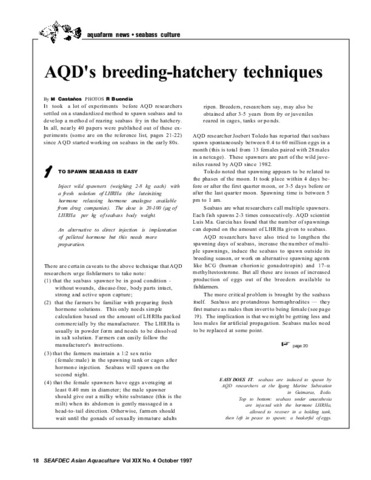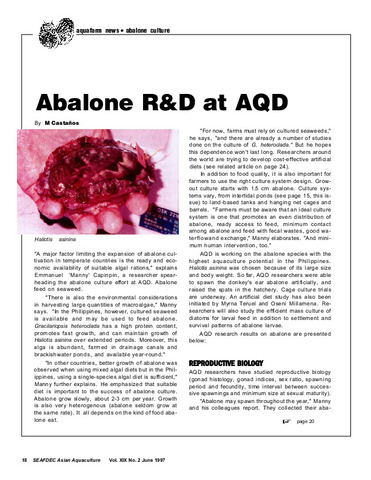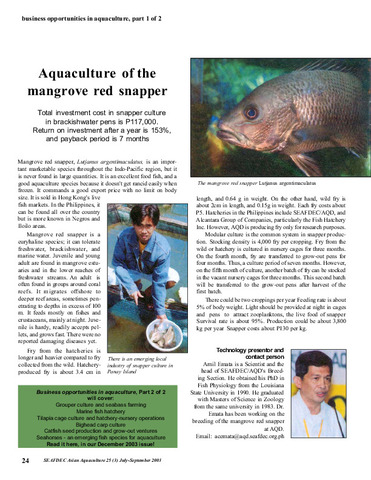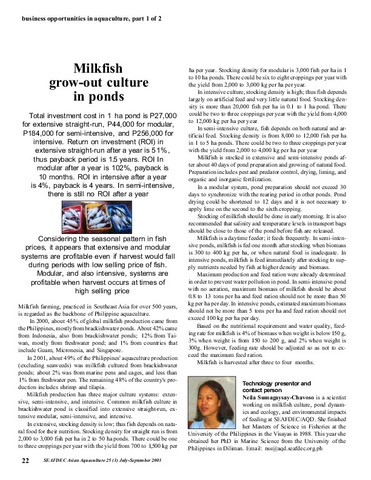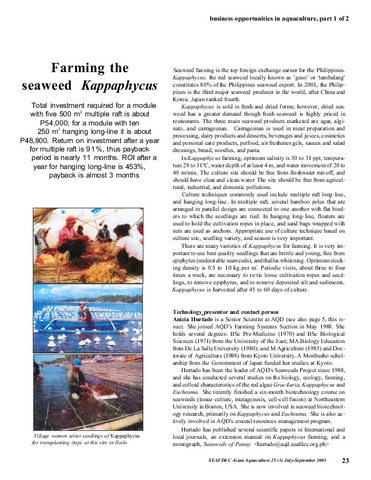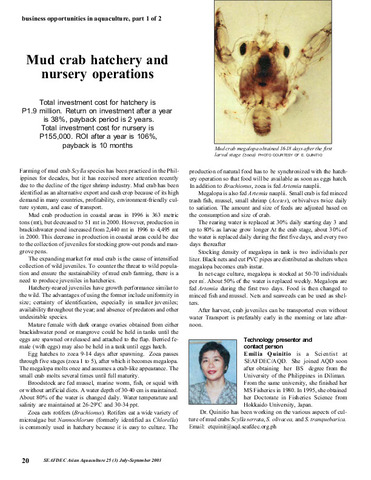Journals/Magazines: Recent submissions
Now showing items 541-560 of 591
-
Tuna markets and farming: Japan and Australia
(Aquaculture Department, Southeast Asian Fisheries Development Center, 2000) -
Audie Lim's successful milkfish grow-out: pass it on!
(Aquaculture Department, Southeast Asian Fisheries Development Center, 2000) -
The Jamandre bangus hatchery
(Aquaculture Department, Southeast Asian Fisheries Development Center, 2000) -
Realizing green aquaculture
(Aquaculture Department, Southeast Asian Fisheries Development Center, 2000) -
I'd like to invest in aquaculture, what choices do I have?
(Aquaculture Department, Southeast Asian Fisheries Development Center, 2000)The Philippines, which lies 5th in terms of aquaculture production world-wide, has one of the highest per capita fish consumptions in the world. This makes aquaculture a very promising industry when viewed in relation to ... -
Managing Laguna lake for the small fishermen
(Aquaculture Department, Southeast Asian Fisheries Development Center, 1987)Based on a study (Laguna de Bay: Problems and Options) by Jon Davis, Flor Lacanilao and Alejandro Santiago published by the Haribon Foundation as "White Paper No. 2", April 1986. -
A glimpse into some sea cucumbers in Panay, Philippines
(Aquaculture Department, Southeast Asian Fisheries Development Center, 2000)Except for coastal dwellers, most Filipinos do not know what sea cucumbers are, although most must have dined on them at some time. A description is given of what sea cucumbers are and how they look, how they are processed ... -
Crocodile farming: a multi-million dollar industry
(Aquaculture Department, Southeast Asian Fisheries Development Center, 2000)Crocodiles have a long breeding life, which ranges from 25-30 years. There are 27 species and subspecies of crocodiles throughout the world, 18 of which are in danger of extinction, the rest being threatened with declining ... -
Malaysian school engages in bullfrog and turtle farming
(Aquaculture Department, Southeast Asian Fisheries Development Center, 2000)A brief description is given of the culture methods used in the Sepang Today Aquaculture Centre, a private aquafarming training school in Malaysia, regarding American bullfrog (Rana catesbeiana) and the soft-shelled turtle ... -
The sargeant fish and the eel
(Aquaculture Department, Southeast Asian Fisheries Development Center, 2000)The culture of sargeant fish, or cobia (Rachycentron canadum) and eel (Anguilla spp) in the Philippines is discussed. Market potentials for the cultured products are examined. -
The culture of seabass
(Aquaculture Department, Southeast Asian Fisheries Development Center, 1997)Seabass (Lates calcarifer) are raised in ponds and cages in Southeast Asia. Details are given of the 2 phases involved in the pond and culture culture systems -- nursery and grow-out. Both monoculture and polyculture systems ... -
Mangrove community structure survey
(Aquaculture Department, Southeast Asian Fisheries Development Center, 2003)Highlights are given of a mangrove community structure survey conducted in the coastal barangays of Carles, Panay Island, Philippines, in April 2003. The survey aimed to qualitatively describe the species composition, ... -
Abalone culture: a new business opportunity
(Aquaculture Department, Southeast Asian Fisheries Development Center, 2003)There are about 100 species of abalone in the world, but only 20 are of high commercial importance. In the Philippines, the abalone species are Haliotis asinina, H. varia, H. ovina and H.glabra, but it is the former which ... -
AQD's breeding-hatchery techniques
(Aquaculture Department, Southeast Asian Fisheries Development Center, 1997)Details are given of standardized methods used by AQD for the spawning of seabass (Lates calcarifer) and the rearing of fry in the hatchery. -
Abalone R&D at AQD
(Aquaculture Department, Southeast Asian Fisheries Development Center, 1997)Details are given of the results of research conducted at the SEAFDEC Aquaculture Department on abalone (Haliotis asinina). The following areas are covered: reproductive biology; induced spawning; raising abalone in the ... -
The seabass market
(Aquaculture Department, Southeast Asian Fisheries Development Center, 1997)Seabass (Lates calcarifer) are high value fish occupying a market niche with snappers and groupers. An examination is made of the seabass market in Asia, considering the current situation in the Philippines, Malaysia, Hong ... -
Aquaculture of the mangrove red snapper
(Aquaculture Department, Southeast Asian Fisheries Development Center, 2003)Mangrove red snapper (Lutjanus argentimaculatus) is an important marketable species throughout the Indo-Pacific region. It is a euryhaline species; it can tolerate freshwater, brackishwater and marine water. Modular culture ... -
Milkfish grow-out culture in ponds
(Aquaculture Department, Southeast Asian Fisheries Development Center, 2003)Milkfish farming is regarded as the backbone of Philippine aquaculture. In 2001, nearly 50% of the Philippines' aquaculture production was milkfish cultured from brackishwater ponds. It has 3 major culture systems: extensive; ... -
Farming the seaweed Kappaphycus
(Aquaculture Department, Southeast Asian Fisheries Development Center, 2003)Seaweed farming is the top foreign exchange earner for the Philippines. Kappaphycus constitutes 80% of the Philippine seaweed export. It is sold in both fresh and dried forms; although dried seaweed has a greater demand, ... -
Mud crab hatchery and nursery operations
(Aquaculture Department, Southeast Asian Fisheries Development Center, 2003)A brief account is given of mud crab (Scylla spp) farming activities in the Philippines. The expanding market for mud crab is the cause of intensified collection of wild juveniles. To counter the threat to wild population ...

